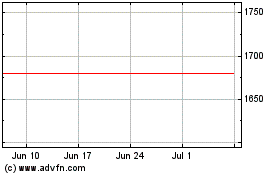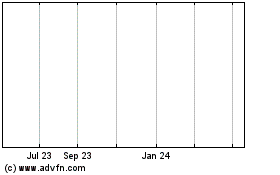By Stu Woo
The U.S. government has upended the $35 billion-a-year
cellular-equipment industry, ushering in a new era of competition
and giving U.S. companies a shot at re-entering a sector they
vacated years ago.
In the past five years, only China's Huawei Technologies Co.,
Sweden's Ericsson AB and Finland's Nokia Corp. captured more than a
20% share of revenue in the wireless-equipment market, according to
Dell'Oro Group, a research firm. No other competitor consistently
cracked even 10%.
Now that landscape is changing. Pushed by Washington's campaign
to cripple Huawei over cybersecurity concerns, countries
representing more than 60% of the world's cellular-equipment market
are considering or have already enacted restrictions against
Huawei, says Dell'Oro Group. And to take advantage of that opening,
the U.S. government -- as well as governments in the U.K. and
European Union -- are considering financial support and other
measures to boost domestic cellular-equipment makers trying to
crack the three incumbents' stranglehold on the market.
The result is a newly competitive market that is reminiscent of
the 1990s, when bygone industry giants such as Lucent, Motorola,
Nortel, Siemens and Alcatel fought for a piece of a growing
telecom-equipment pie.
"It's got a Wild West feel to it," says Bill Plummer, a former
Nokia and Huawei executive now working at JMA Wireless, a Syracuse,
N.Y., 5G company. "We haven't seen this since probably the eve of
the dot-com bust -- this dynamic and thriving competitive
environment in wireless."
That new environment could benefit everyone -- other than, of
course, Huawei, Ericsson and Nokia. It will give a host of
competitors a chance to win business that only a couple of years
ago seemed out of reach. And the new competitive fervor should
increase innovation and lower costs for wireless carriers, which
could pass on savings -- and the fruits of those innovations -- to
customers.
American officials further say the new competitive landscape is
crucial to U.S. efforts to counter China's influence in developing
5G technology, the next generation of wireless technology that will
serve as the building blocks for all sorts of future technologies
-- whether in robot-run factories, heart-rate monitors, or any
number of industries and products. The country that dominates 5G
will be well-positioned to lead the technology industry in terms of
profits and talent in the years ahead.
The 3G days
After a vibrant start to the 3G era in the 2000s, when
manufacturers throughout North America, Europe and Asia competed,
equipment manufacturers started consolidating amid pressure from
Huawei and another Chinese company, ZTE Corp., which were both
selling increasingly competitive hardware at lower prices. In 2016,
Nokia's acquisition of Alcatel-Lucent, itself a merger of French
and American companies, created today's three-giant oligopoly.
The Trump administration began loosening the trio's grip on the
market in 2018 when it started urging allies to blacklist industry
leader Huawei over national-security concerns. The campaign worked:
Huawei lost market share outside China to both Ericsson and Nokia
last year, according to Dell'Oro Group, as governments enacted or
considered restrictions on Huawei's equipment.
"The big change over the past couple of years is pressure on
Huawei," says James Barford, a telecom analyst for Enders Analysis.
"Even in countries where there is no formal ban, you're going to be
thinking twice" about using equipment from the Chinese company.
The stranglehold of the big three was further weakened by
Nokia's blunder in procuring expensive chips for its 5G equipment
-- a mistake that resulted in its equipment costing more upfront,
as well as consuming more power. That's an issue for wireless
carriers, which can spend roughly 20% of operating expenses on
energy. Nokia says it has since moved to cheaper, power-efficient
chips, but damage was done: Some carriers looked elsewhere for
supplies.
With both Huawei and Nokia under pressure, that left Ericsson as
the market leader outside China. But that, in turn, made wireless
carriers' executives wary. They say they want more competition to
increase innovation and reduce costs.
The result has been an opening for a whole new generation of
competitors -- and the Wild West environment.
The open gambit
Some carriers are turning to Samsung Electronics Co., the South
Korean smartphone giant that is a relative newcomer to the
wireless-infrastructure industry. It ranked fifth behind the three
giants and China's ZTE in 2020, but won a major victory last year
when Verizon Communications Inc. switched suppliers from Nokia to
Samsung.
But it's the possibility of buying 5G equipment using
open-standards software that has the most potential for roiling the
competitive order.
To understand why, consider that the cellular equipment that
transmits signals to phones consists of three parts: the antenna,
hardware that sits on a pole directly under the antenna, and more
hardware at the pole's base. Huawei, Ericsson and Nokia currently
sell all three parts in a bundle, and they aren't interoperable.
For instance, a Huawei antenna doesn't work with Ericsson
electronics under the antenna.
It would be like buying a Dell laptop that works with only a
Dell monitor and Dell printer. And it means customers have limited
options on price, quality and features.
Enter a new technology based on open standards, dubbed Open RAN,
or radio access network. Companies making equipment based on these
standards allow wireless carriers to mix and match the antennas
with different under-antenna hardware and centralized electronics.
That gives carriers more options for cost and quality.
The U.S. government is a major backer of the open-software
efforts, which officials say could boost both U.S. national
security and business. It potentially can help U.S. businesses by
creating openings for new players, and because these new efforts
rely less on hardware (where the U.S. has fallen behind) and more
on software (where companies such as Microsoft Corp. and
International Business Machines Corp. can potentially play a
role).
"We may be able to increase security, reduce our exposure to any
single foreign vendor, lower costs and push the equipment market to
where the United States is uniquely skilled -- in software,"
Federal Communications Commission Acting Chairwoman Jessica
Rosenworcel said in March.
If U.S. companies do indeed become major players in 5G
equipment, then they can also play a bigger role in setting global
standards for telecom equipment. That's an arena where China has
made great strides. U.S. officials prefer that companies in the
U.S. and allied democracies set wireless standards, which they
believe would lead to greater, less hackable security.
President Biden and Japanese Prime Minister Suga Yoshihide last
month agreed that the U.S. and Japan would collaborate to advance
open 5G networks "by fostering innovation and by promoting
trustworthy vendors and diverse markets," the White House said.
Congress this year enacted a law to establish a Commerce Department
fund that would award grants to support the use of such
open-standards equipment in the U.S. A bipartisan group of
lawmakers backing the bill requested $750 million for the fund in
fiscal year 2022.
In the U.K., a government-appointed task force to help British
wireless carriers transition away from Huawei equipment recommended
that new equipment makers, or those using open-standards software,
represent 25% of the country's wireless infrastructure by the
mid-2020s. The task force recommended government incentives for
wireless carriers buying such equipment, and for suppliers to
locate research facilities in the U.K. The European Union this year
started examining similar options.
The focus of newcomers
Several smaller U.S. companies -- such as Airspan Networks,
Altiostar, Mavenir, JMA and Parallel Wireless -- are focused on 5G
equipment using open software. Ericsson and Nokia are also shifting
to using some open-standard software.
The new challengers have signed deals with some big carriers.
AT&T Inc. is testing open-standards equipment and plans to
gradually introduce it, while newcomer wireless-carrier Dish
Network Corp. has said its entire network would rely on such
infrastructure.
Dell'Oro Group predicts that equipment using open standards,
from both newcomers and incumbents transitioning into the new
market, will capture 10% of the market by 2025.
"The operators say, 'We need choice, we need a strong
ecosystem,' " says Thierry Maupilé, a former Motorola and Cisco
Systems Inc. executive who now works at Altiostar, which provides
software for open-standards 5G equipment. "You have a playing field
that has been reduced to a few companies."
Still, open-standards equipment remains in its early stages, and
it is too soon to know whether it will be a major player. Wireless
carriers say their tests of open-standards equipment show some
drawbacks. The new technology can be less energy-efficient than
today's conventional systems. And while the open-standards
equipment can be used in rural areas, its performance isn't yet up
to snuff in densely populated urban areas.
But wireless carriers expect the open-standards equipment to be
on par with Huawei, Ericsson and Nokia equipment in three or four
years.
"For us, it is critical to maintain competition in our vendor
system," says Michael Trabbia, chief technology officer at French
carrier Orange SA. "We cannot end up with only two players."
Mr. Woo, a Wall Street Journal reporter in London, can be
reached at stu.woo@wsj.com.
(END) Dow Jones Newswires
May 26, 2021 12:14 ET (16:14 GMT)
Copyright (c) 2021 Dow Jones & Company, Inc.
Samsung Electronics (PK) (USOTC:SSNHZ)
Historical Stock Chart
From Dec 2024 to Jan 2025

Samsung Electronics (PK) (USOTC:SSNHZ)
Historical Stock Chart
From Jan 2024 to Jan 2025
